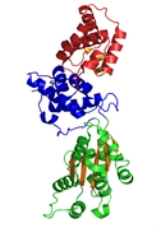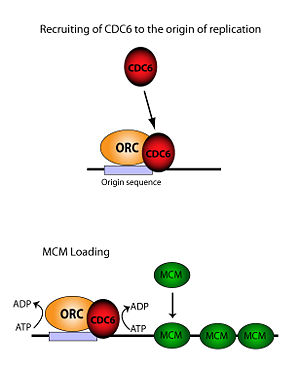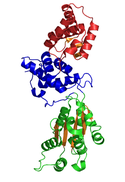
Cdc6
Encyclopedia
Cdc6, or Cell Division Cycle 6, is a protein
in eukaryotic cells that is studied in the budding yeast Saccharomyces cerevisiae
. It is an essential regulator of DNA replication
and plays important roles in the activation and maintenance of the checkpoint mechanisms in the cell cycle
that coordinate S phase
and mitosis
. It is part of the pre-replicative complex (pre-RC)
and is required for loading Mini Chromosome Maintenance
(MCM) proteins onto the DNA, an essential step in the initiation of DNA synthesis. In addition, it’s a member of the family of AAA+ ATPases
and highly associated to Orc1p.
 Cdc6p is an ATP
Cdc6p is an ATP
binding protein and a member of the pre-replicative complex (pre-RC)
together with the origin recognition complex (ORC)
, Cdt1 and the MCM complex (containing MCM2-7p). Cdc6p assembles after ORC in an ATP dependent manner and is required for loading MCM proteins onto the DNA. Reconstruction of electron microscope
images showed that the ORC-Cdc6p complex forms a ring-shaped structure with similar dimensions to those of ring-shaped MCM helicase.
It is thought that the Cdc6p-Cdt1 complex uses ATP hydrolysis to thread DNA through the central hole of the MCM doughnut. Mutations in the binding motif of Cdc6p strongly suggest that ATP binding and hydrolysis is essential for its function. The minimal requirement for DNA binding has been mapped within its 47-amino acid sequence. Furthermore Cdc6 indirectly inhibits activation of the p34cdc2/CDC28 M phase kinase, thus nuclear division is suppressed.
. This is partly because the CDC6 gene is only transcribed during G1 phase. On the onset of the S phase, Cdc6p gets phosphorylated by the Cdc28-Clb5-Clb6 complex (Cdk1) and consequently becoming inactivated. This has been shown by introducing mutations in Cdc6p at the consensus sites for Cdk1 phosphorylation (near the N-terminus) which inhibit degradation. The phosphorylation can furthermore be catalyzed by Cdc28-Cln. The inactivated Cdc6p is then targeted for degradation by SCFCDC4-dependent ubiquitinylation and afterwards degraded by the proteosome. Thus, the regulation of Cdc6p is tightly correlated to the activity of Cdk1 and since Cdk1-activity is oscillating once per cell cycle, the accumulation and degradation of Cdc6p also oscillates.
Two states can be distinguished. In the first state (during G1 phase) Cdk1-activity is low, Cdc6p can accumulate, hence the pre-RC can be formed but not activated. In the second state Cdk1-activity is high, Cdc6p becomes inactivated, hence the pre-RC is activated but not formed. This change assures that DNA replication
is performed only once per cell cycle. It has been shown that overexpression of Cdc6p does not induce re-replication in cognate cells, probably due to inhibition through CDK that resets the cell
cycle clock to G1. Nevertheless it has been suggested that regulation of Cdc6p is one of several redundant mechanisms that prevent re-replication of the DNA in eukaryotic cells.
 The crystallographic structure
The crystallographic structure
of a Cdc6p/Orc1-related protein from Pyrobaculum aerophilum (see Pyrobaculum
) has been solved and three structural domains have been identified. Domain I and II form the ATP binding/hydrolysis site and are similar Similar to other AAA+ ATPases. Domain III is structurally related to a winged-helix domain, thus may interact with origin DNA. From studies with E. coli γ clamp loading complex, it was suggested that domain III mediates protein-protein interactions with other AAA+ ATPases in the pre-RC, thus suggesting that the Cdc6p builds a homodimer in its native form. The domains I and II form a cashew-shaped molecule that bind ATP
in the cleft and additionally build the sensor motif for ATP/ADP recognition. These domains are also thought to mediate subsequent conformational changes. Nevertheless, the exact functional roles of these domains remain unclear.
activity. Cdc6 overexpression interferes with the expression of INK4/ARF tumor suppressor
genes through a mechanism involving the epigenetic modification of chromatin
at the INK4/ARF locus. In addition, Cdc6p overexpression in primary cells may promote DNA hyperreplication and induce a senescence
response similar to that caused by oncogene activation. These findings indicate that deregulation of CDC6 expression in human cells poses a serious risk of carcinogenesis. Down-regulation of CDC6 in prostate cancer
was observed and associated with phenotypic characteristics of aggressive prostate cancer. Furthermore it has been
observed that Cdc6 is greatly up-regulated in cervical cancer
, lung cancer
and brain cancer.
Protein
Proteins are biochemical compounds consisting of one or more polypeptides typically folded into a globular or fibrous form, facilitating a biological function. A polypeptide is a single linear polymer chain of amino acids bonded together by peptide bonds between the carboxyl and amino groups of...
in eukaryotic cells that is studied in the budding yeast Saccharomyces cerevisiae
Saccharomyces cerevisiae
Saccharomyces cerevisiae is a species of yeast. It is perhaps the most useful yeast, having been instrumental to baking and brewing since ancient times. It is believed that it was originally isolated from the skin of grapes...
. It is an essential regulator of DNA replication
DNA replication
DNA replication is a biological process that occurs in all living organisms and copies their DNA; it is the basis for biological inheritance. The process starts with one double-stranded DNA molecule and produces two identical copies of the molecule...
and plays important roles in the activation and maintenance of the checkpoint mechanisms in the cell cycle
Cell cycle
The cell cycle, or cell-division cycle, is the series of events that takes place in a cell leading to its division and duplication . In cells without a nucleus , the cell cycle occurs via a process termed binary fission...
that coordinate S phase
S phase
S-phase is the part of the cell cycle in which DNA is replicated, occurring between G1 phase and G2 phase. Precise and accurate DNA replication is necessary to prevent genetic abnormalities which often lead to cell death or disease. Due to the importance, the regulatory pathways that govern this...
and mitosis
Mitosis
Mitosis is the process by which a eukaryotic cell separates the chromosomes in its cell nucleus into two identical sets, in two separate nuclei. It is generally followed immediately by cytokinesis, which divides the nuclei, cytoplasm, organelles and cell membrane into two cells containing roughly...
. It is part of the pre-replicative complex (pre-RC)
Pre-replication complex
A pre-replication complex is a protein complex that forms at the origin of replication during the initiation step of DNA replication. Formation of the pre-RC is required for DNA replication to occur. Complete and faithful replication of the genome ensures that each daughter cell will carry the...
and is required for loading Mini Chromosome Maintenance
Mini Chromosome Maintenance
Mini Chromosome Maintenance complex, or Minichromosome Maintenance protein complex or mini-chromosome maintenance 2-7 helicase complex has a role in both the initiation and the elongation phases of eukaryotic DNA replication, specifically the formation and elongation of the replication fork...
(MCM) proteins onto the DNA, an essential step in the initiation of DNA synthesis. In addition, it’s a member of the family of AAA+ ATPases
AAA proteins
AAA or AAA+ is an abbreviation for ATPases Associated with diverse cellular Activities. They share a common conserved module of approximately 230 amino acid residues...
and highly associated to Orc1p.
Function

Adenosine triphosphate
Adenosine-5'-triphosphate is a multifunctional nucleoside triphosphate used in cells as a coenzyme. It is often called the "molecular unit of currency" of intracellular energy transfer. ATP transports chemical energy within cells for metabolism...
binding protein and a member of the pre-replicative complex (pre-RC)
Pre-replication complex
A pre-replication complex is a protein complex that forms at the origin of replication during the initiation step of DNA replication. Formation of the pre-RC is required for DNA replication to occur. Complete and faithful replication of the genome ensures that each daughter cell will carry the...
together with the origin recognition complex (ORC)
Origin Recognition Complex
ORC or Origin Recognition Complex is a multi-subunit DNA binding complex that binds in all eukaryotes in an ATP-dependent manner to origins of replication....
, Cdt1 and the MCM complex (containing MCM2-7p). Cdc6p assembles after ORC in an ATP dependent manner and is required for loading MCM proteins onto the DNA. Reconstruction of electron microscope
Electron microscope
An electron microscope is a type of microscope that uses a beam of electrons to illuminate the specimen and produce a magnified image. Electron microscopes have a greater resolving power than a light-powered optical microscope, because electrons have wavelengths about 100,000 times shorter than...
images showed that the ORC-Cdc6p complex forms a ring-shaped structure with similar dimensions to those of ring-shaped MCM helicase.
It is thought that the Cdc6p-Cdt1 complex uses ATP hydrolysis to thread DNA through the central hole of the MCM doughnut. Mutations in the binding motif of Cdc6p strongly suggest that ATP binding and hydrolysis is essential for its function. The minimal requirement for DNA binding has been mapped within its 47-amino acid sequence. Furthermore Cdc6 indirectly inhibits activation of the p34cdc2/CDC28 M phase kinase, thus nuclear division is suppressed.
Regulation
Cdc6p is normally present at high levels during the G1 phase of the cell cycleCell cycle
The cell cycle, or cell-division cycle, is the series of events that takes place in a cell leading to its division and duplication . In cells without a nucleus , the cell cycle occurs via a process termed binary fission...
. This is partly because the CDC6 gene is only transcribed during G1 phase. On the onset of the S phase, Cdc6p gets phosphorylated by the Cdc28-Clb5-Clb6 complex (Cdk1) and consequently becoming inactivated. This has been shown by introducing mutations in Cdc6p at the consensus sites for Cdk1 phosphorylation (near the N-terminus) which inhibit degradation. The phosphorylation can furthermore be catalyzed by Cdc28-Cln. The inactivated Cdc6p is then targeted for degradation by SCFCDC4-dependent ubiquitinylation and afterwards degraded by the proteosome. Thus, the regulation of Cdc6p is tightly correlated to the activity of Cdk1 and since Cdk1-activity is oscillating once per cell cycle, the accumulation and degradation of Cdc6p also oscillates.
Two states can be distinguished. In the first state (during G1 phase) Cdk1-activity is low, Cdc6p can accumulate, hence the pre-RC can be formed but not activated. In the second state Cdk1-activity is high, Cdc6p becomes inactivated, hence the pre-RC is activated but not formed. This change assures that DNA replication
DNA replication
DNA replication is a biological process that occurs in all living organisms and copies their DNA; it is the basis for biological inheritance. The process starts with one double-stranded DNA molecule and produces two identical copies of the molecule...
is performed only once per cell cycle. It has been shown that overexpression of Cdc6p does not induce re-replication in cognate cells, probably due to inhibition through CDK that resets the cell
cycle clock to G1. Nevertheless it has been suggested that regulation of Cdc6p is one of several redundant mechanisms that prevent re-replication of the DNA in eukaryotic cells.
Structure

X-ray scattering techniques
X-ray scattering techniques are a family of non-destructive analytical techniques which reveal information about the crystallographic structure, chemical composition, and physical properties of materials and thin films...
of a Cdc6p/Orc1-related protein from Pyrobaculum aerophilum (see Pyrobaculum
Pyrobaculum
In taxonomy, Pyrobaculum is a genus of the Thermoproteaceae.- Description and Significance :As its latin name, Pyrobaculum suggests, the archaeon is rod-shaped and isolated from locations with high temperatures. It is Gram-negative and its cells are surrounded by an S-layer of protein subunits.P...
) has been solved and three structural domains have been identified. Domain I and II form the ATP binding/hydrolysis site and are similar Similar to other AAA+ ATPases. Domain III is structurally related to a winged-helix domain, thus may interact with origin DNA. From studies with E. coli γ clamp loading complex, it was suggested that domain III mediates protein-protein interactions with other AAA+ ATPases in the pre-RC, thus suggesting that the Cdc6p builds a homodimer in its native form. The domains I and II form a cashew-shaped molecule that bind ATP
Adenosine triphosphate
Adenosine-5'-triphosphate is a multifunctional nucleoside triphosphate used in cells as a coenzyme. It is often called the "molecular unit of currency" of intracellular energy transfer. ATP transports chemical energy within cells for metabolism...
in the cleft and additionally build the sensor motif for ATP/ADP recognition. These domains are also thought to mediate subsequent conformational changes. Nevertheless, the exact functional roles of these domains remain unclear.
Disease
It has been shown Cdc6p shows proto-oncogenicOncogene
An oncogene is a gene that has the potential to cause cancer. In tumor cells, they are often mutated or expressed at high levels.An oncogene is a gene found in the chromosomes of tumor cells whose activation is associated with the initial and continuing conversion of normal cells into cancer...
activity. Cdc6 overexpression interferes with the expression of INK4/ARF tumor suppressor
ARF tumor suppressor
The ARF tumor suppressor is a protein that is transcribed from an alternate reading frame of the INK4a/ARF locus . ARF is induced in response to sustained mitogenic stimulation, such as aberrant growth signaling from MYC and Ras . It accumulates mainly in the nucleolus where it forms stable...
genes through a mechanism involving the epigenetic modification of chromatin
Chromatin
Chromatin is the combination of DNA and proteins that make up the contents of the nucleus of a cell. The primary functions of chromatin are; to package DNA into a smaller volume to fit in the cell, to strengthen the DNA to allow mitosis and meiosis and prevent DNA damage, and to control gene...
at the INK4/ARF locus. In addition, Cdc6p overexpression in primary cells may promote DNA hyperreplication and induce a senescence
Senescence
Senescence or biological aging is the change in the biology of an organism as it ages after its maturity. Such changes range from those affecting its cells and their function to those affecting the whole organism...
response similar to that caused by oncogene activation. These findings indicate that deregulation of CDC6 expression in human cells poses a serious risk of carcinogenesis. Down-regulation of CDC6 in prostate cancer
Prostate cancer
Prostate cancer is a form of cancer that develops in the prostate, a gland in the male reproductive system. Most prostate cancers are slow growing; however, there are cases of aggressive prostate cancers. The cancer cells may metastasize from the prostate to other parts of the body, particularly...
was observed and associated with phenotypic characteristics of aggressive prostate cancer. Furthermore it has been
observed that Cdc6 is greatly up-regulated in cervical cancer
Cervical cancer
Cervical cancer is malignant neoplasm of the cervix uteri or cervical area. One of the most common symptoms is abnormal vaginal bleeding, but in some cases there may be no obvious symptoms until the cancer is in its advanced stages...
, lung cancer
Lung cancer
Lung cancer is a disease characterized by uncontrolled cell growth in tissues of the lung. If left untreated, this growth can spread beyond the lung in a process called metastasis into nearby tissue and, eventually, into other parts of the body. Most cancers that start in lung, known as primary...
and brain cancer.

